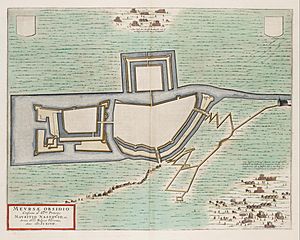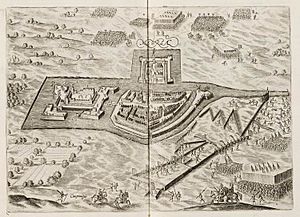Siege of Meurs (1597) facts for kids
Quick facts for kids Siege of Meurs |
|||||||
|---|---|---|---|---|---|---|---|
| Part of the Eighty Years' War and the Anglo–Spanish War |
|||||||
 Siege of Meurs from the Atlas Van Loon |
|||||||
|
|||||||
| Belligerents | |||||||
| Commanders and leaders | |||||||
| Strength | |||||||
| 7,000 Infantry 1,200 Cavalry |
400 | ||||||
| Casualties and losses | |||||||
| Unknown (low) | All captured | ||||||

The siege of Meurs was a short but important battle that happened from August 29 to September 3, 1597. It was part of two bigger wars: the Eighty Years' War and the Anglo–Spanish War. The city of Moers (which was called Meurs by the Dutch back then) was controlled by Spain. Dutch and English soldiers, led by Prince Maurice of Orange, attacked the city. The Spanish commander, Andrés de Miranda, eventually gave up. This victory was a key part of Prince Maurice's very successful military plan in 1597, which was known as the Ten Glory Years.
Contents
Why the Siege Happened
Moers Under Spanish Control
Moers had been taken over by the Spanish in 1586. A Spanish governor named Sacchinus Camillo de Modiliana was put in charge, along with a small group of soldiers.
Dutch Plans for a New Campaign
By the middle of 1597, the Dutch government in The Hague had more money for their army. They told Prince Maurice of Orange, who was the leader of the Dutch and English troops, to start a new attack. The Spanish army was busy fighting somewhere else, at the siege of Amiens, so it was a good time to strike.
Maurice's Strategy and First Target
Prince Maurice planned to lead his army through the eastern part of the Netherlands. His main goals were two strong cities, Grol and Oldenzaal. On August 1, 1597, Maurice and his cousin William Louis set out. They had 7,000 foot soldiers and 1,200 cavalry (soldiers on horseback). This included thirteen groups of English soldiers and ten groups of Scottish soldiers, all led by Colonel Horace Vere. Maurice's first target was Rheinberg, an important city that Spain had held for seven years. After a ten-day siege, the Spanish gave up Rheinberg on August 19. Maurice then moved his army south towards Moers.
The Siege of Moers
Defenses of Moers
Moers was located on the western side of the Rhine River. It had a strong fortress and a castle. The governor of Spanish Upper Guelders, Herman van den Bergh, sent more soldiers to Moers. This brought the total number of Spanish defenders to 400, led by Andrés de Miranda.
The Attack Begins
When Prince Maurice arrived, his army surrounded Moers from two sides. On August 29, his cannons began firing at the city. Engineers in his army also started filling in parts of the moat (the ditch around the city) in three places. This was so the soldiers could get closer and attack the city walls.
Spanish Surrender
Moers did not put up much of a fight against the Dutch and English forces. Parts of the city wall began to crumble. Even before the main attack could happen on September 3, the Spanish commander, de Miranda, started talking about giving up. Prince Maurice agreed to his terms. Miranda and his soldiers marched out of the city with their honor intact. Maurice's troops then entered Moers. They made the city's defenses stronger and left some soldiers there to guard it.
After the Siege
After taking Moers, Prince Maurice continued his campaign. On September 8, he marched to Orsoy, crossed the Rhine River, and then the Lippe River. By the evening of September 11, he was outside Groenlo. He then besieged Groenlo for eleven days, forcing its soldiers to surrender as well.
See also
- List of stadtholders in the Low Countries
- List of governors of the Spanish Netherlands
- Siege of Rheinberg (1597)
- Siege of Bredevoort (1597)

